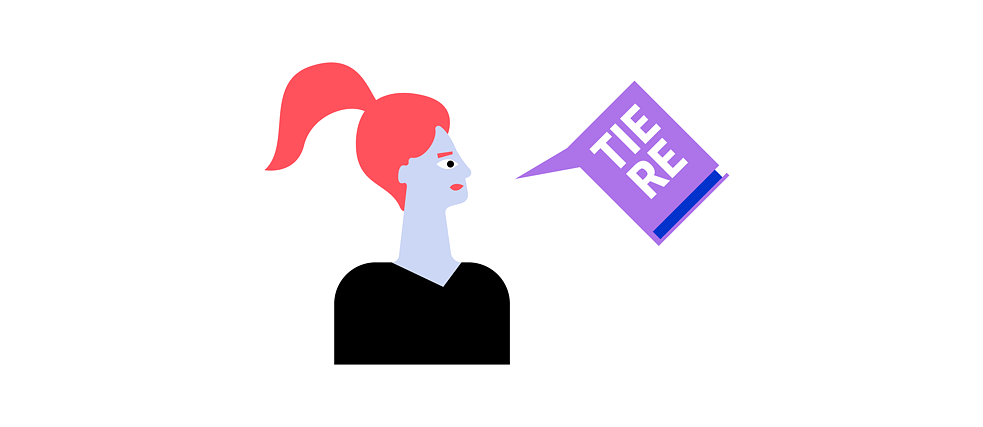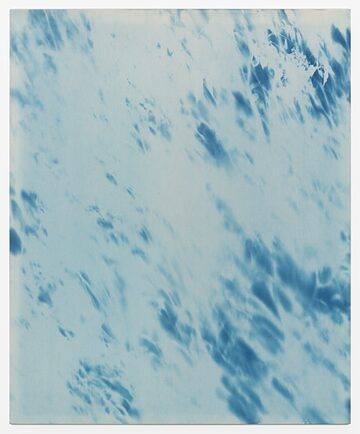Word! The Language Column
Writing for and with other animals

In her final column, Manon Hopf takes this opportunity to remind us how we can – and should – write about other animals without using violent language. And the potential offered by poetry to enter into dialogue with them. For example through scent-walk sonnets.
By Manon Hopf
So how can I, how do I want to, speak or write about other animals – after all, the way I speak about them as a human, the way I treat them, has an existential impact on the lives of other animals, over which many people always – repeatedly – assert their superiority violently in both word and deed. Maybe I can come closer in the knowledge that as a human I don’t think and act outside nature, in fact my actions and thoughts are part of nature, the defining value and fulcrum of which is not actually the human, it’s nature itself.
Empathising
So I’m trying to take a step back from myself, empathise with other animals, to understand myself as part of nature the process, to dismantle my perspectives and open myself up to a nature with multiple perspectives – and understand everything in it as agents, as subjects, with the desire for and right to a good life. How can two subjects encounter, view, learn to recognise each other – if not by replacing a unilaterally demanded trust with a questioning, cautious trust from both parties. And the understanding that violence in the context of behaviour towards other animals is not natural [given], it is actually a decision that people make – abusing other animals, humiliating them, keeping them captive, hitting and killing them, whenever and however those people wish to do. Culture is what nature does, writes Karen Barad, and our responsibility is the behaviour upon which our culture is based – towards both each other and other animals.Stopping the suppression or denial that they exist – the diverse relationships that people enter into, and always have entered into, with other animals. Humans have a significance in the lives of other animals – and what exactly that means is something we can influence and we must change. It’s true that other animals have not been considered as things in Germany since 1990, yet regulations must be applied in accordance with a thing, and the killing of other animals is still frequently treated as damage to property. The clear distinction between humans and other animals as a result of the Enlightenment and with Descartes, and therefore viewing other animals as things, as beast machines, changed the perspective on animals permanently, which provided extremely favourable conditions for keeping and slaughtering other animals on an industrial scale.
Resistance
Other animals can look back on a long history of resistance against humans. One could even argue that the repeated and sustained resistance of other animals against their economic exploitation is what caused the use of machines, for instance in agriculture, or at any rate accelerated it. The ongoing and repeated resistance of circus animals has led to a rethink in the circus industry. There have been recurrent incidences of work refusal and violence amongst dolphins and orcas at marine theme parks. And reports of orca attacks on sailing boats off the coast of the Iberian Peninsula are heard with increasing frequency – as a result of which the hashtag #orcanize is now doing the rounds on the internet.But how might other animals benefit if people write narrative verse or lyric poetry about other animals, using poetic means to express the problems and perspectives of other animals pertinently? After all, the readers are always going to be human. Of course the language we use has an influence on how we think about other animals and how we treat them, communicate with them. Poetry can be a means of clarifying the elements that connect humans with other animals, of deconstructing anthropocentric speech, thinking and actions – and thereby at least to prepare for change in the lives of other animals. Shifting from “first think, then act”, which usually gets stuck at the thinking stage, to active thinking, thoughtful action.
the silence upon the new world
when all the words have drowned
are exhausted lying
like carpets of dead birds
in the sea
Poetry without humans
And at the same time there is an increasing interest in entering into dialogue with other animals, in communicating. Hardly anyone who lives and/or works more closely with other animals and actually deepens this relationship with them would claim that empathy and tenderness, devotion or patience, beauty, are exclusively human qualities – they are qualities of this world, of a shared nature. Various proponents of speculative realism also offer opportunities to think outside anthropocentrism – and although their positions are highly diverse, what does unite them is the need for an ideology that extends beyond human beings. But what is most interesting of all is the influence of speculative realism on different art forms, whereby it’s becoming increasingly important to allow nature itself as a creative, poetic actor, and to see humans as just one factor of many possible ones that might be in play in the production of art – nature is the actual subject, not humans. How might that look, feel, sound, smell, taste, (insert verb) – nature speaking constantly: a poetry without humans, or poetry despite humans.Multispecies poetry
Mara-Daria Cojocaru writes poems with and for other animals. One of her poetry approaches is to explore the common ground and differences between humans and other animals, in the way they read the world and communicate – especially with dogs, together with and for whom she lives. Poetry can help to experiment, to play, with other forms of expression alongside human language – to shift systems and perspectives, to deconstruct them. To open yourself up to the languages and senses of other animals, to track them down, suss them out – approaching someone always has to mean going beyond or outside your own comfort zone. Mara-Daria Cojocaru’s Multispecies Poetry is not only supposed to have dogs and other animals as its subject, it’s also meant to involve dogs in the writing and reading processes as co-authors and consumers.One possibility could be writing scent-walk sonnets together:On a walk somewhere that has an interesting or nice-sounding name, you collect samples of material where the dogs sniff. As many samples as there are letters in the name of the place. Then when you get home, the dog is allowed another sniff of the collected samples and together you decide which ones to select. There are three rules: “1. The dog is the lead artist, so watch and learn”, 2. “Have fun with your dog and respect their style”, 3. “Really do think about how dogs read their environment, what they might find interesting – or not so much.” If you like, you can write an acrostic based on the place name – while the human reads the words, both human and dog can read the sniff poem. The result is visual and scent poems that can feature in exhibitions and made available to dogs as well – but if a dog appears unimpressed by the poems unless they represent a light snack, you shouldn’t take it to heart, says Mara-Daria Cojocaru. Most people are not so very different when it comes to poems.
Deconstructing perspectives
With this approach, poetry can be a way to reach the boundaries of knowledge playfully and work in the realm beyond them. It can be an opportunity to learn something about other animals, about dogs and how they perceive the world. About how creative they can be – and how creative humans can be with them. And maybe that would be something we could integrate into our everyday life, that would help us to deconstruct our own perspective again and again, further and further: to really observe from a respectful distance, to be interested in what an other animal is interested in – without causing disruption, without prioritising your own curiosity or perspective. What catches our eye? And when we make eye contact, we know: two very similar individuals could be meeting here and remembering this encounter like an other animal. What it will say about them also depends on how we encounter and have encountered them.Literature on the topic “Poetry of other animals”
Karen Barad: Transmaterialities
Karsten Brensing: Die Sprache der Tiere
Mara-Daria Cojocaru: Anstelle einer Unterwerfung
Mara-Daria Cojocaru: Menschen und andere Tiere
Caspar Henderson, Judith Schalansky (Hg.): Wahre Monster
Eva Meijer, Judith Schalansky (Hg.): Die Sprachen der Tiere
Jan Mohnhaupt: Tiere im Nationalsozialismus
Ana Cristina Santos : LGBTQ+ Intimacies in Southern Europe
Hilal Sezgin: Artgerecht ist nur die Freiheit
Word! The Language Column
Our column “Word!” appears every two weeks. It is dedicated to language – as a cultural and social phenomenon. How does language develop, what attitude do authors have towards “their” language, how does language shape a society? – Changing columnists – people with a professional or other connection to language – follow their personal topics for six consecutive issues.
